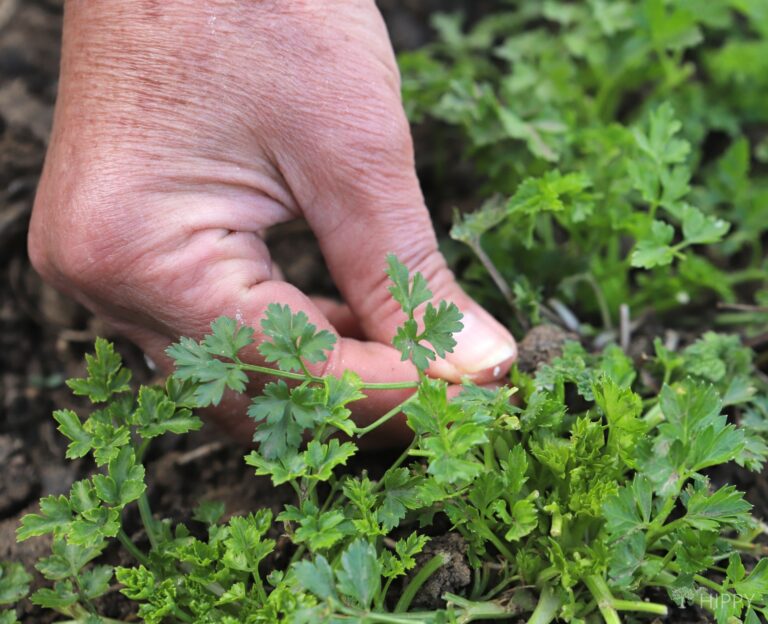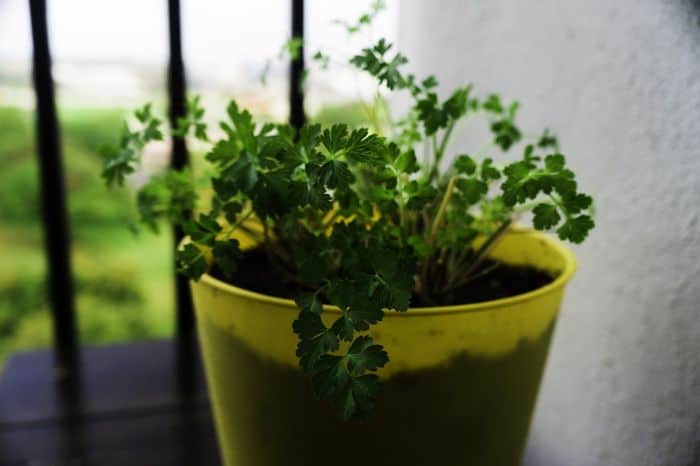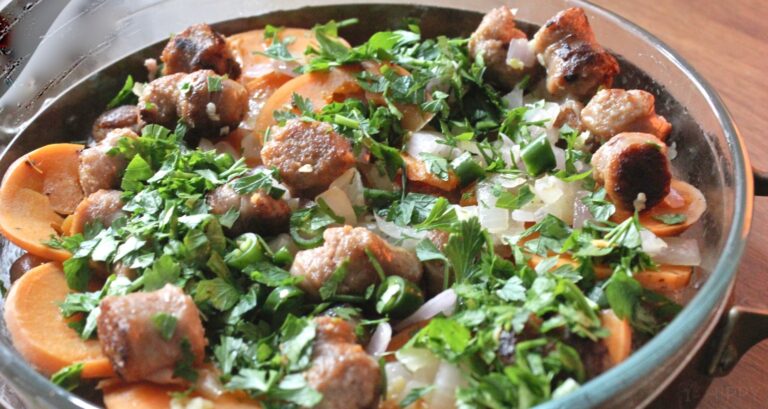As a child, you likely viewed parsley as just the frilly garnish sitting atop your main course. As an adult, you’ve hopefully discovered how wonderful and delicious parsley is, as well as how versatile it is in your cooking.
Parsley is an easy-to-grow herb that has a place in any garden, big or small, and can be cultivated by any kind of grower.

Parsley is a biennial, meaning it comes back after two gardening seasons. This gives your plant time to produce leaves and go to seed. In this time, it also develops a hefty taproot.
Table of Contents
Benefits of Parsley
As a versatile plant, parsley can be used in many different cooking styles. It helps to tie together the flavors of a meal and adds a bright note, as well as a dose of important nutrients.
This herb is a nutritional powerhouse, packed with vitamins K, C, B, and A. It also has tons of iron and potassium. As a natural diuretic, it helps eliminate excess fluid, reducing bloat and other symptoms of water retention.
Parsley is also a good source of one of the hardest-to-find vitamins, folic acid. Folic acid helps regulate your bodily functions and protects your blood vessels. It’s especially important for pregnant women.
If you grow your own parsley, you receive all of these health benefits – and then some. Parsley is a great pest repellant in the garden, helping to keep away problem species that may afflict your other garden plants.
When grown as a companion to species like tomatoes, it can improve the appearance and overall growth of your garden.
Plus, a homegrown garden is more likely to be free of dangerous pesticides and herbicides that can make you sick. Growing your own parsley is a great way to boost your health and radically improve the flavor of your meals at the same time.
Types of Parsley
Parsley is a close relative of carrots, dill, and celery, which you’ve likely noticed if you’ve ever closely observed the top, leafy part of the plant.
When you’re selecting the best varieties of parsley to grow in your garden, keep in mind that there are two major types: flat leaf or curly leaf. Japanese parsley and Hamburg parsley are two lesser-known (but equally delicious!) varieties.
Flat-leaf parsley has a vibrant flavor and is easy to use in most dishes. It chops easily and can be stored for long-term use. This type grows up to 36 inches in height and has flavorful properties.
There are several subtypes of flat-leaf parsley, like Italian Flat Leaf (which has a peppery flavor and appearance not unlike that of cilantro) and Giant of Italy (a large plant that is hardy under most growing conditions).
Curly-leaf parsley, on the other hand, is also delicious. It has a slightly more unique appearance, giving it added flair when you’re growing it in your outdoor herb bed or even on your windowsill. Curly parsley is versatile and easy to grow.
There are several popular sub-types of curly-leaf parsley, including Forest Green parsley and Extra Curled Dwarf parsley. Extra Curled Dwarf parsley grows in a compact bush, maturing rapidly for an earlier harvest.
Japanese parsley is native to Japan and China, as the name implies, and is actually a perennial – instead of biennial – type of parsley. This evergreen herb has a bitter flavor and is usually eaten like celery.
Hamburg parsley, on the other hand, has thick roots like a parsnip and is typically used in soups and stews. This variety of parsley looks somewhat like a fern.
Preparing the Soil for Parsley
Parsley prefers to be grown in rich, well-drained soil. Spread a few inches of organic matter, like compost or aged manure, on the soil a few weeks before planting.
To ensure a super nutrient-dense soil, consider sowing a cover crop over the planting area the fall before you intend to plant.
This will fix nitrogen into the soil and also reduce the need to till in the spring, allowing a higher content of nutrients to remain in the soil without removing any beneficial microorganisms.
Once you’ve thoroughly fertilized the soil with organic matter, you should spade the soil to a depth of roughly eight or nine inches. If you have any aged compost leftover, you can turn a bit of it back into the soil. This will help further fertilize your soil to prepare it for planting.
Parsley can be grown relatively early in the spring, but shouldn’t be planted when there is still a danger of frost. Although it is relatively cold-hardy, a frost can kill your plant or stunt its growth.
Wait for the weather to warm up. While you can attempt to warm the soil earlier by using mulch or other methods, it is not advised that you use the black plastic method of planting for this plant.
It tends to be more fragile and sensitive to too much heat, which could pose problems as the weather warms up throughout the summer.
Optimal Growing Conditions
In the north, parsley is an annual and not a biennial. It will last from spring until freezing weather.
If you live in a warmer area without a lot of winter snowfall, it can survive a frost and may be able to survive through winter, allowing you to get two years of production out of one plant.
When you see your parsley plant begin to flower, it is time to pull the plant, as it is past its prime.
If you live in zones 7 or warmer, you can plant parsley in the fall, but any areas colder than that should have parsley planted in the spring. In the south, you can even grow parsley throughout the winter!
Parsley plants prefer full sun, but can also tolerate partial shade. The soil must be nutrient-dense, ideally with a pH between 5.5 and 6.7. It needs to be kept moist at all times, and mulch can be helpful to keep the roots cool.
Planting Parsley
Many people start parsley seeds indoors about eight weeks before the last expected frost in your area. You can determine your last expected date of frost by estimating based on last year’s data or by visiting the USDA Zone Hardiness map to determine your average dates.
Starting your seeds indoors will ensure that you have a healthy supply of parsley seedlings ready to be planted as soon as the weather warms up. This will give you an earlier harvest of parsley, allowing you to gather more of the tasty leaves throughout the growing season.
When you start your seeds inside, choose small pots that are well-draining. You can use repurposed containers or use peat pots.
Peat pots are particularly effective because you can plant the entire container in the soil, removing the risk of shocking the delicate roots of the parsley.
Plant a small pinch of seeds on the surface of the soil (a well-draining potting mix works best), and then press the seeds gently into the soil. To help the seeds germinate more quickly, cover them with clear plastic.
This will keep them warm and moist. Once your seeds emerge, remove the plastic to reduce the likelihood of fungal growths. Make sure your seedlings are placed in a location with plenty of sunlight and keep the potting soil damp by misting lightly whenever it feels dried out.
The planting process is easy, regardless of whether you have chosen to plant seeds or seedlings. Once the weather has warmed and you are ready to plant, you can spread your seeds or plant your seedlings in rows about ten to twelve inches apart.
If planting seeds, make sure they are spaced roughly half an inch apart. This can be a challenge, as parsley is a fine seed that can be hard to disseminate evenly. Simply thin your seedlings as they emerge in the fall if they seem to be too overcrowded.
Caring for Parsley Plants
Make sure you water your parsley plant regularly. It does not need to be watered every day and should be kept moist instead of sodden.
If you mulch your parsley plants, this can help regulate moisture and reduce the frequency with which you need to water. However, keep in mind that too much mulch combined with too much water can lead to root rot.
In the fall (typically late August or early September), you can promote new growth by cutting back the plants. Pruning can help produce new vegetation and allow a fresh harvest until the first snow.
Humans aren’t the only ones who like parsley – it is also commonly targeted by certain pests. The parsley worm caterpillar, in particular, loves feasting upon this pest. These caterpillars, which later turn into black swallowtail butterflies, usually appear in late summer or fall.
Swallowtail butterflies are beneficial to your garden, acting as important pollinators, so you don’t need to kill them. These pests tend to eat most of the plant, but they won’t totally kill it in most cases. You can usually cut back the dead or eaten pieces to encourage new growth.
Another pest you might find atop your parsley plants is the whitefly. This pest can kill your plants and can be removed by spraying the bottoms of your leaves with insecticidal soap.
Parsley can also attract hoverflies, which are not dangerous in themselves and can instead eat aphids, thrips, and other plants that prey upon parsley plants.
Companion Planting Parsley
Parsley is a lush plant, growing up to a foot high in most cases. It produces nice green foliage, meaning it works well when grown in beds, containers, window boxes or even in the middle of your flower bed.
Even if you are growing it for culinary or medicinal purposes, don’t hesitate to plant it with your flowers! As a companion plant, it provides many benefits that cannot be overlooked.
Parsley can grow well alongside most plants, except for mint and lettuce. It can be planted with chives, carrots, chili peppers, onions, bell peppers, asparagus, tomatoes, or even corn.
Roses can also be planted near parsley with good results; in fact, some gardeners believe that planting parsley near the base of your rosebushes will improve their fragrance.
Harvesting Parsley
Harvesting parsley is an interesting process, as it’s a biennial. When you harvest parsley in its first year, you should harvest only the leaves, selecting those from stalks that are the farthest from the plant’s center.
Allow the inner stalks and leaves to remain so that the plant can keep growing. You can take multiple cuttings throughout that first growing season, and in fact, the more frequently you cut the plant, the more vigorously it will grow.
During the second year of growth, you may find that your parsley is producing fewer leaves that are duller in flavor than they were the first year. Not to worry! This is simply a sign that your plant is setting deep roots.
Allow the plant to go to bloom, and collect the seeds so that you can sow them the following spring.
When you’re ready to harvest your parsley, the process is simply. First, try to select younger plants, as these will have the best flavor. Wait until each leaf stem has three or more segments.
Stems with fewer than three segments are not yet mature and should be left to finish growing before they are harvested. In general, parsley may be harvested about eighty days after it was seeded.
When you harvest, cut only at the base of the plant. Snip the herb off at the bottom instead of cutting from the top. This will encourage the plant to produce more stems, which can increase your overall yield.
The outer portions are the best places from which to harvest, which will allow the inside of the plant to mature longer. It removes old growth, naturally pruning the plant and allowing for a resurgence of growth.
You can harvest continually throughout the season, and you don’t need to harvest your entire parsley plant all at once.
Try not to remove more than a third of the plant at a time. Outdoor-grown parsley will remain green until late fall. When its color fades, the flavors will also begin to decline.
If you keep your parsley outdoors during the winter (if you have a particularly harsh winter, that is), it will die back.
However, you can harvest it in full before the first snowfall, or bring it inside throughout the winter months. Indoor grown parsley will allow you to maintain your parsley supply without losing the plant to the harsh winter elements.
If you live in a climate that allows you to overwinter your parsley, you will experience a second season of parsley growth. When fall arrives during the second year of growth, in addition to harvesting parsley leaves, you may also harvest the root of the parsley.
Many people overlook the taproots of the parsley plant, but it’s incredibly flavorful and can be eaten raw like a carrot, or shaved over salads for a unique, pungent burst of flavor.

Growing Parsley in Containers
If you aren’t blessed with acres of outdoor space, you might think that growing parsley is not an option for you. Think again!
It’s easy to grow parsley indoors, just as you would outside. Parsley can thrive in a container, allowing you to grow it on your balcony or even your windowsill.
Parsley should be grown in a container that is at least one gallon in volume. You will need at least this much soil, and parsley develops a powerful taproot that needs plenty of room to sprawl.
A pot that is anywhere between eight and fourteen inches in diameter should suit your needs just fine.
You should use a potting soil that is rich in organic matter.
Those that include fresh ingredients like pasteurized soil, peat moss, ground bark, compost, and composted manure are the best options, as these will be well-draining and provide your plants with plenty of nutrients.
Parsley needs to be placed in full sun, although ti can tolerate small amounts of shade. Ideally, your plant should receive six hours of direct sunlight every day.
Keep your parsley plant moist, and don’t allow it to dry out completely. Containers tend to dry out more quickly than plants growing outdoors, so make sure you check your plants regularly.
When it’s time to water, water the plant until water appears from the drainage holes. Sometimes, you may need to water your plant as often as twice a day.
Keep in mind that you may need to provide additional fertilizer when growing your parsley in a container. This is because the soil will eventually be depleted of nutrients that were originally provided in the potting mix.
Fertilize once every other week with a water-soluble fertilizer designed for herbs. You can also use compost or worm tea if you prefer an organic solution.
You will harvest, use, and store your parsley exactly as you would when growing it outdoors. Keep in mind that your new leaves might regenerate a bit more slowly when growing inside, as they will not be exposed to the same outdoor elements.
Using and Storing Parsley
Parsley is best used fresh and can often be stored for a few weeks without a loss of flavor. However, there are multiple ways you can store your parsley if you want it to last even longer (up to several years, in some cases!).
If you are removing a few leaves from the plant at a time you should use your parsley supply immediately so you don’t become inundated with a supply. You can wrap parsley in a damp paper towel and keep it in the refrigerator for two days.

If you are pulling several sprigs at once, you can put them in the refrigerator for seven days – just make sure to put them in a vase of water, as you would flowers.
Many people swear by freezing their parsley. This will allow you to keep entire sprigs of parsley, and once it is thawed, it can be used in a similar fashion as fresh parsley.
The easiest way to freeze parsley is to cut leaves into small portions and place them in ice cube trays.
Add a bit of water or olive oil, and then simply add the cubes to your dish when you are ready to use them. The frozen parsley won’t be as crisp as fresh parsley, but it will still have excellent flavor.
You can also dry your parsley. This will allow you to store it in the long-term, using it as needed. Parsley can be dried by hanging it in full bunches upside-down from the ceiling.
Make sure you are drying it in a well-ventilated, dark, and warm area inside. It takes about a week to dry. You can also dry your parsley in a conventional food dehydrator. After parsley is dehydrated, it will last several months.
Parsley has countless culinary uses, pairing well with meat and egg dishes, as well as in pasta, vegetable dishes, rice, soups, and salads.
It can be added during the cooking process or just before serving. Even the stems of parsley can be used in cooking. They make a great addition to pesto or chimichurri, adding texture and flavor to the meal.
Parsley is more than just a garnish, and it’s incredibly easy to grow. What’s stopping you? Grow a fragrant bouquet of parsley in your garden today to provide you with endless culinary opportunities.


Rebekah is a full-time homesteader. On her 22 acres, she raises chickens, sheep, and bees, not to mention she grows a wide variety of veggies. She has a huge greenhouse and does lots of DIY projects with her husband in her ever-growing homesteading endeavor. Learn more about Rebekah here.
